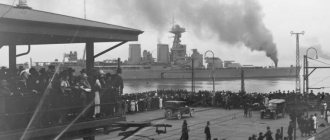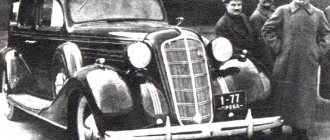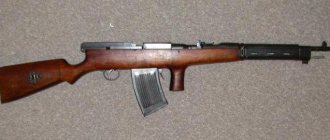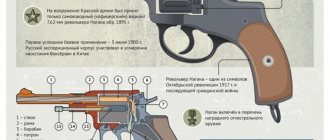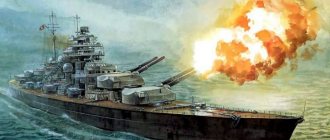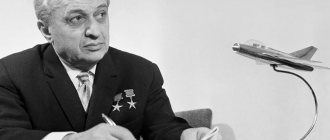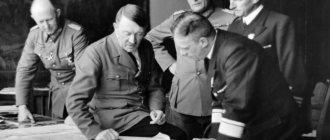Early biography
Politician Gerald Ford was born on July 14, 1913.
Moreover, his name at birth was different - Leslie Lynch King. Then Leslie's parents separated, and in 1916 his mother Dorothy King entered into a new marriage - with a man named Gerald Rudolph Ford. Ultimately, he gave his adopted son not only his last name, but also his first name. The family of Gerald and Dorothy lived in the town of Grand Rapids. As a child, Ford was a member of the Boy Scouts. It is known that in 1927 he was awarded the highest rank in this movement - “Eagle Scout”.
It is also known that Gerald, when he was at school, was the leader of the American football team. He continued to play football as a student and achieved significant progress in this sport.
Until 1935, Ford was educated at the University of Michigan, and in 1941 he also graduated from Yale University Law School.
The emergence of nuclear aircraft carriers
With the development of nuclear power, many marine experiments and tests were carried out. For this purpose, they used a number of aircraft carriers that survived the Second World War, but were not able to take on board new heavy aircraft. After conducting a series of studies, America decided to do the incredible. Construction began on a fundamentally new aircraft-carrying vessel, the likes of which had no analogues in the world. It was the nuclear attack super aircraft carrier Enterprise. It was put into operation in 1961.
Its length is 342 meters. The possibility of autonomous navigation reached 13 years. This was many times greater than the capabilities of all other aircraft carriers in the United States and the world. Enterprise served in the Cuban Missile Crisis and the Vietnam War.
In 1969, a tragic event occurred: one of the missiles, due to the negligence of the crew, exploded and crashed into the tank of one of the aircraft standing on the deck. The disaster killed 27 people and total property damage amounted to $126 million.
After repair work and modernization of a number of elements, the ship continued to participate in combat operations. In particular, in Afghanistan and Iraq. In 2011, he was spotted off the coast of Somalia, where he helped in the fight against sea pirates. In 2012, the aircraft carrier was withdrawn from the fleet. However, it was only in February 2017 that it was officially decommissioned. This was due to the fact that the US Navy planned to replace the Enterprise with a new American supercarrier, which would not be ready until 2022.
Nimitz-class aircraft carriers
The main aircraft carriers currently operating in the US Navy are Nimitz-class vessels. The ships, like the Enterprise and the new Ford, have a nuclear power plant. The first ship of this type was put into operation in 1975, the last in 2009. The production cost is $4.5 billion, operation is possible for 50 years. The recharge period of a nuclear reactor is 20 years. A total of 10 units were produced.
Nimitz aircraft carriers took an active part in operations related to military conflicts in Yugoslavia and Iraq. It is unknown how high-quality armor is installed on US aircraft carriers, since they are currently in use, but there is reason to believe that 63.5 mm thick Kevlar plates were used during production. Such protection is not enough against a direct hit from modern missiles, but the US Navy's air defense systems will prevent these missiles from approaching the danger zone around the ship.
Attack aircraft carrier Nimitz
| Type: Nimitz attack aircraft carriers | ||
| Name | Commissioned | Removed from the fleet |
| "Nimitz" USS Nimitz (CVN-68) | May 3, 1975 | Is in service |
| "Dwight Eisenhower" USS Dwight D. Eisenhower (CVN-69) | October 18, 1977 | Is in service |
| "Carl Vinson" USS Carl Vinson (CVN-70) | May 13, 1982 | Is in service |
| "Theodore Roosevelt" USS Theodore Roosevelt (CVN-71) | October 25, 1986 | Is in service |
| "Abraham Lincoln" USS Abraham Lincoln (CVN-72) | November 11, 1989 | Is in service |
| "George Washington" USS George Washington (CVN-73) | July 4, 1992 | Is in service |
| "John C. Stennis" USS John C. Stennis (CVN-74) | December 9, 1995 | Is in service |
| "Harry Truman" USS Harry S. Truman (CVN-75) | July 25, 1998 | Is in service |
| "Ronald Reagan" USS Ronald Reagan (CVN-76) | July 12, 2003 | Is in service |
| "George Bush" USS George HW Bush (CVN-77) | January 10, 2009 | Is in service |
Gerald Ford during the war
In 1942, after the United States officially entered World War II, Ford enrolled in a military instructor course. And after completing these courses, he trained soldiers in a range of naval disciplines.
In 1943, Gerald Ford was assigned to the USS Monterey, and until the end of 1945 he participated in several operations in the Pacific theater.
History of the creation of US aircraft carriers
Elisabeth Fritzl: biography, photo
The idea of creating a floating runway belongs to the Americans. And this is not surprising. The main battles almost always take place off the coast of North America, and the United States has always sought to control any military conflicts.
During the First World War, the British fleet was actively used; after the end of hostilities, America carefully studied the actions of British naval aviation. The first US aircraft carrier was converted from a coal carrier and named CV-1 Langley. A 163-meter-long deck was created on the ship and cranes were installed to lift aircraft on board. The following ships, the aircraft carrier Lexington (CV-2) and the aircraft carrier Saratoga (CV-3), were converted from battleships during the construction phase.
CV-1 Langley
The year 1927 is an important date in the history of American aircraft carriers. This year, a decision was made to build (and not re-equip) the first five aircraft-carrying ships
Each of the ships could accommodate from 70 to 80 aircraft.
In the first half of the last century, aircraft-carrying ships of different sizes and, accordingly, differing in purpose, appeared in a number of countries. Several classes of ships were distinguished:
- Light aircraft carrier. The ship is small in size compared to analogues of another class, and can accommodate from 20 to 50 aircraft.
- Escort aircraft carrier. It is a subtype of light aircraft carrier. These ships were rebuilt from civilian ships. A feature of this technology was its low speed and unreliability in battles. Langley's first experimental aircraft carrier can be attributed specifically to this class of ships.
- Heavy/attack aircraft carrier. It is a type of large ship that allows horizontal takeoff and landing. Accommodates from 70 to 100 aircraft. Such naval equipment is capable of inflicting large-scale attacks on the enemy and can remain far from the coast for a long time. During the war and in the post-war period, US aircraft carriers such as the Essex and Midway were built.
Career and personal life from 1946 to 1973
At the beginning of 1946, Ford was transferred to the US Navy Reserve (at that time he was already a lieutenant commander). After this, Ford became a lawyer and also became involved in real politics.
At the same time, important changes took place in the personal life of the future president. In 1948, he married Elizabeth Ford (maiden name Bloomer). The couple lived together until their death, they had four children - three sons (Michael, Jack and Stephen) and a daughter (her name is Susan).
Also in 1948, Ford nominated himself as a Republican candidate for the House of Representatives. And in the end, he managed to defeat the incumbent congressman (he was a supporter of the Democratic Party) and take his place.
Ford was subsequently re-elected many times. He sat in the House of Representatives without interruption until 1973 (and since 1965, Ford was the leader of the Republican faction in it).
Ford became famous as a politician who vehemently criticized Lyndon Johnson's social reforms, collectively known as the Great Society. In addition, he strongly opposed the escalation of the conflict in Vietnam.
And then a whole series of events happened that brought Ford to the presidency. First, in 1973, Vice President Spiro Agnew resigned from his post due to allegations of tax evasion. Nixon appointed Ford to this position (they had known each other since the late forties).
And just 9 months later the so-called Watergate scandal broke out. And as a result, Nixon himself was forced to resign (thus he wanted to avoid impeachment).
History of the name
Gerald R. Ford in US Navy uniform, 1945.
In 2006, while Gerald Ford was still alive, Virginia Senator John Warner proposed changes to the 2007 National Defense Authorization Act, proposing that CVN-78 "should be named USS Gerald Ford
"
The final version of the law, signed by President George W. Bush on October 17, 2006, stated that it was only "the opinion of Congress that ... CVN-78 should be named USS Gerald Ford
." Since "expressions of opinion" are generally non-binding and do not have the force of law, the Navy was not required to name the ship after Ford.
On January 3, 2007, former US Secretary of Defense Donald Rumsfeld announced during a memorial speech at Grace Episcopal Church in East Grand Rapids, Michigan, that an aircraft carrier might be named after Ford. Rumsfeld noted that he personally told Ford this during a visit to his home in Rancho Mirage, a few weeks before Ford's death. This makes the aircraft carrier one of the few US ships named after a living person. The US Navy later confirmed that the aircraft carrier could be named after the former president. On January 16, 2007, US Secretary of the Navy Donald Winter officially named CVN-78 USS Gerald R. Ford.
. Ford's daughter Susan Ford was named as the ship's sponsor. The announcement was made at the Pentagon, and the ceremony was attended by Vice President Dick Cheney, Senators Warner (R-Va.) and Levin (D-Mich.), Lt. Gen. Guy C. Swan III, Bales, Ford's three other children, and others.
Activities in the presidency
As a result, on August 9, 1974, Gerald Ford became president, in accordance with the 25th Amendment of the Constitution. To do this, he did not have to win the election, which is a unique case in American history.
Having come to power, Ford immediately pardoned the previous president - freed him from responsibility for all the crimes that he could have committed when he ruled the country. Critics believed that this amnesty was the result of secret agreements between Nixon and Ford, in other words, a price for the presidency.
Ford, as the head of the United States, continued to adhere to the course of détente in relations with the USSR (Secretary of State Henry Kissinger is considered the key ideologist of this course). In 1974, he even visited the Soviet Union. In Primorye, in Vladivostok, he met face to face with the then leader of the USSR Brezhnev.
Also during Ford's short reign, progress was made in arms limitation negotiations, the Conference on Security and Cooperation in Europe was held and the so-called Helsinki Accords were signed.
In addition, it was under Ford, in 1975, that the Vietnam War ended. Moreover, the communist forces of the North celebrated their victory. And in Angola, in the same 1975, power (with the support of the USSR and Cuba) was taken over by representatives of the left-wing MPLA party.
It is also worth noting that as president, Ford faced major problems within the country. Inflation was growing rapidly in the United States, and as part of the fight against it, the presidential administration carried out a large-scale public campaign, which, however, did not produce noticeable results.
The downturn in the American economy forced the Ford government to resort to a certain reduction in government spending. Ford over and over again vetoed Congressional decisions to allocate money for certain non-military purposes. It is interesting that in Congress, both in the upper and lower houses, after the so-called midterm elections of 1974, the Democrats had a majority.
It is also worth noting that President Ford was the subject of two assassination attempts. On September 5, 1975, Lynette Fromme, one of Charlie Manson's most devoted supporters, tried to eliminate him. Just 17 days later, Ford was shot with a revolver by a woman named Sarah Jane Moore. The bullet, fortunately, flew past.
In the 1976 intra-party primaries, Ford managed to defeat a rather formidable opponent, Ronald Reagan.
And directly in the elections, Democrat Jimmy Carter became Ford's competitor. And although Ford was mercilessly criticized for pardoning Nixon (as well as for a number of other mistakes), experts believed that he had a very real chance of winning and remaining in the Oval Office. However, Gerald Ford did not have a very successful televised debate with his opponent, and in the end it was Carter who celebrated the victory by a slight margin.
After leaving the White House, Ford did not take an active part in politics, but was an important person in the American Enterprise Institute.
Cruiser design
General view of the design of the new aircraft carrier
Most technical characteristics, including displacement, were not much different from the Nimitz line of ships it replaced. A key direction in the development of the new American aircraft carrier Gerald Ford was to automate processes. It was expected that such a solution would reduce the labor intensity of servicing all systems by 30% and, accordingly, reduce the ship’s crew.
In terms of appearance, several options were considered, including a stealth design. However, it was decided to postpone the construction of a new type until technology develops. As a result, the design of the aircraft carrier was left the same as that of previous generations. Such a decision was also supposed to reduce production costs.
A characteristic feature of the line that has carried over into the new aircraft carriers is the command room, moved closer to the stern. The flagship bridge was moved to the lower deck to reduce the size of the superstructure. The flight deck has been expanded and there are 18 points for refueling and arming aircraft. To reduce weight, the number of hangar sections was reduced from three to two, and aircraft lifts from four to three.
Constructive protection
The aircraft carrier is considered one of the most vulnerable ships. Its structural protection does not imply the presence of significant armor against enemy attacks. The emphasis is on radar stealth, which allows the ship to remain hidden from enemy radars for as long as possible, as well as on air defense and missile defense.
It is for this purpose that the shape and dimensions of the superstructure were redesigned and reduced. The cabins and some of the premises were moved into the hull, and the superstructure itself was located behind the side line. The mast is made of composite materials that absorb radar pulses.
Frame
The hull of the aircraft carrier was designed taking into account the main threats to the ship - guided missiles, torpedoes, and shaped charges. In this context, in addition to standard armor and self-defense equipment, the emphasis is on reducing radar and optoelectronic signature.
To achieve this, the hull has rounded sides connecting to the flight deck and special coatings. The stealth technologies used do not make the ship invisible. These measures are needed to make the aircraft carrier indistinguishable from the rest of the ships in the group and, accordingly, reduce the attack priority.
Decks
Flight deck of an aircraft carrier without aircraft
A distinctive feature of the aircraft carrier Gerald R. Ford is the increased area of the flight deck. This was achieved by reducing the command superstructure and moving a number of rooms into the building. The flagship bridge, designed for 70 crew members, was moved to the lower deck. Additionally there is a corner flight deck.
The design uses general developments from the Nimitz line. It is expected that further ships of the new series of aircraft carriers will receive additional changes to the hull and decks. This makes the Gerald Ford a transitional and to some extent experimental ship from traditional design to the use of new technologies.
Finisher
The aircraft take-off and landing systems on the new aircraft carrier have also been redesigned. The electromagnetic catapult (EMC) is equipped with a new electric motor, which gives the device certain advantages:
- the installation capacity increased to 122 MJ instead of 95;
- power is adjusted depending on the weight of the aircraft being launched;
- easy operation, including maintenance;
- weight reduced to 225 tons, volume - to 425 cubic meters. m versus 500 tons and 1100 cubic meters. m for previous models.
Thanks to these qualities, the catapult is able to ensure that the aircraft takes off in less wind and with less load on the aircraft. There are also 35 fewer service personnel required.
Navigation and optical system
The navigation equipment has been redesigned to incorporate the latest technologies and systems. The general focus on automation made it possible to optimize many processes, reducing the number of crew members and improving the ship control system.
The optical system was developed in a similar way. Automated lighting of instruments and decks at night allows you to solve assigned tasks without loss of efficiency. All systems are powered by new reactors designed specifically for this ship.
Health problems and death
In the early years of the 21st century, the 38th President of the United States began to have serious health problems. He suffered two heart attacks and went to the hospital many times. At some point, he even had a device sewn into him that supported the activity of his heart.
At recent business meetings, Gerald and his wife Elizabeth received guests while sitting; they no longer had the strength to stand for long.
On December 26, 2006, Ford died in California, on his own ranch. The 38th President of the United States was buried in Grand Rapids, where a significant part of his life passed, on the grounds of the memorial museum named after him. Thousands of people saw off the famous politician on his last journey.
Increased efficiency
USS Gerald R. Ford is one of the first class of aircraft carriers that has performance improvements over the previous Nimitz
.
USS Gerald R. Ford is equipped with an active phased array multifunction radar. The replacement of traditional steam catapults with an electromagnetic launch system ( EMALS
) will begin with this aircraft carrier.
This innovation eliminates the traditional requirements for generating and storing steam, freeing up a significant amount of space. With the introduction of the EMALS
, USS Gerald R. Ford will be able to launch 25% more aircraft per day than
Nimitz
and require 25% fewer crew members. This is estimated to save $4 billion in operating costs over its 50-year lifespan.
Content
- 1 Biography 1.1 Childhood and youth
- 1.2 World War II
- 1.3 Political career
- 1.4 Presidency 1.4.1 Domestic politics
- 1.4.2 Relations with the USSR
- 1.4.3 End of the Vietnam War
- 1.4.4 Politics in the Middle East
- 1.4.5 Relations with the PRC
- 1.4.6 Formation of the G7
- 1.4.7 Situation in East Timor
- 1.4.8 Economy
Memory[ | ]
Postage stamps, coins and medals have been issued in memory of Gerald Ford. Also named in honor of Ford are the US Navy aircraft carrier Gerald R. Ford, highways in Nebraska and Michigan, one of the office buildings of the Capitol complex, a highway in Colorado, the airport in Grand Rapids, the school of public policy at the University of Michigan and other various objects .
Films, books and articles are devoted to the life and work of the ex-president. Most authors consider the presidency of Ford, who accidentally ended up in the White House, to be weak and argue that he left a mark in US history only as the person who pardoned Nixon.
Notes[ | ]
- ↑ 1 2 Bibliothèque nationale de France
identifier BNF (French): open data platform - 2011. - ↑ 12
Gerald Ford // Encyclopædia Britannica (English) - Gerald Rudolph Ford // Brockhaus Encyclopedia (German)
- https://www.washingtonpost.com/wp-dyn/content/article/2006/12/26/AR2006122601257.html
- [in early childhood, after his parents’ divorce, he was renamed in honor of his stepfather and received his last name]
- Ivanyan E. A.
Encyclopedia of Russian-American relations. XVIII-XX centuries.. - M.: International relations, 2001. - 696 p. — ISBN 5-7133-1045-0. - 1975 Year in Review. Ford Assasinations Attempts
- Moramarco M. Freemasonry in the past and present BIOGRAPHIES OF MASONS
How it all began
The development of the future sea giant started back in 1996; all the nuances were settled and construction finally began only in 2005. The Navy leadership wanted to get an innovative combat mechanism that would be head and shoulders above the existing ones. Therefore, the emphasis was initially placed on modern developments of the country’s military-industrial complex. After all, it is precisely advanced technologies that can not only increase the combat effectiveness of a vessel, but also significantly reduce the costs of its construction and maintenance.
Construction of the aircraft carrier CVN-79
It took a special commission exactly nine years to draw up a clear plan for the construction of a multifunctional ship. And this is not at all strange, since it was necessary to create an aircraft carrier capable of moving over any distance with a decent baggage of aircraft, helicopters and manpower. Accordingly, it was necessary to develop an effective energy complex, which was based on completely new physical principles. In addition, the commission members wanted to increase the speed of the aircraft carrier, so this issue also needed fresh solutions.
Story
The 555-ton conning tower is moved into place on the flight deck during a ceremony at the Newport News Shipyard in January 2013.
Construction
On September 10, 2008, the US Navy signed a $5.1 billion contract to design and build the aircraft carrier with Northrop Grumman Shipbuilding, which had begun construction of the carrier ahead of a $2.7 billion contract in 2005. Construction began at Huntington Ingalls Industries (formerly Northrop Grumman) Newport News Shipbuilding (19,000 employees) in Newport News, Virginia.
The new ship's keel was ceremoniously laid on November 14, 2009 at Dry Dock No. 12 by Ford's daughter, Susan Ford Bales. In a speech to the assembled workers and Defense Department officials, she said: “Father faced the difficult challenge of restoring confidence in the presidency and healing the wounds of the nation after Watergate, and only he knew how to do it with absolute honesty and integrity. And we remember this legacy this morning.”
As stated in August 2011, the aircraft carrier is “structurally half ready.” In April 2012, readiness was estimated at 75%. On May 24, 2012, a major milestone was reached in completing the ship's hull above the waterline when the bow was raised and set in place. This was the 390th (out of about half a thousand) lifting operation of solid modular parts (from which the ship is assembled). On October 8, 2012, Huntington Ingalls Industries reported in a press release that they had “reached 87% completion of the CVN-78 Gerald R. Ford
" By December 19, 2012, structural construction work had reached 90%. “Of the approximately 500 lifting jobs required to complete the ship, 446 have been completed.”
USS Gerald R.Ford in dry dock during construction.
The cutting installation, originally scheduled for 2012, took place on January 26, 2013.
On April 9, 2013, the aircraft carrier's flight deck was completed following the addition of the upper bow section, bringing the ship to 96% structural completion.
On May 7, 2013, the last of 162 major lifting operations was completed, bringing the ship to 100% structural completion. The remaining work is painting the hull, installing shafts, completing electrical work, installing and adjusting mooring equipment and radar antennas, and filling the dry dock with water.
On July 11, 2013, in continuation of the traditions of the US Navy, a time capsule was welded on the aircraft carrier.
On November 9, 2013, at 11:00 a.m. (East Coast time), the aircraft carrier's launching ceremony took place, and a bottle was broken on the side of the ship by Susan Ford Baze, daughter of Gerald Ford. The ship's readiness at this time, according to representatives of the US Navy, was 70%.
In June 2016, Bloomberg published news that the aircraft carrier had not passed the combat capability test, and its commissioning was postponed to 2022. The US Department of Defense's Office of Operational Testing and Evaluation has determined that many of the ship's critical systems have serious problems, some of which can only be corrected by redesign. The problem areas are the aircraft take-off and landing systems (preliminarily, the runway needs to be replaced) and air traffic control (catapult), as well as the ship’s self-defense and weapons delivery systems (the commission’s specialists were unable to test 11 ammunition lifts). The ship's electromagnetic catapult can only make 400 launches, after which it is likely to fail (instead of the required 4166 launches). The aerofinisher can receive 25 planes in a row, after which it will fail (instead of the required 1600 landings). The capabilities of the dual-band radar are also unknown - the radar was tested only on land, and with unfinished software.
On April 8, 2022, the aircraft carrier went to sea for sea trials for the first time.
On May 31, 2022, the Gerald R. Ford was commissioned into the US Navy. The current US President Donald Trump took part in the commissioning ceremony. He called the aircraft carrier "a 100,000-ton message to the world." Currently, the aircraft carrier does not have a formed air group, which makes it uncombat ready.

